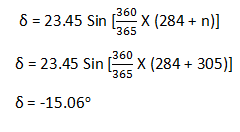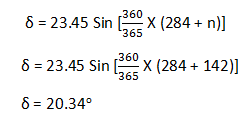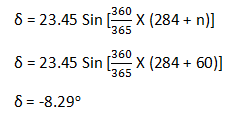This set of Energy Engineering Multiple Choice Questions & Answers (MCQs) focuses on “Solar Radiation Measurement”.
1. Angle made by plane surface with horizontal is called ________
a) Slope
b) Altitude angle
c) Zenith angle
d) Hour Angle
View Answer
Explanation: The slope is the angle made by the plane surfaces with the horizontal. It is considered positive for surfaces slopping towards the south and negative for surface slopping towards the north. Different types of measurements are calculated by slopes.
2. The angle of deviation of the normal to the surface from the local meridian is called as _________
a) Surface azimuth angle
b) Solar azimuth angle
c) Solar altitude
d) Hour angle
View Answer
Explanation: Surface azimuth angle is the angle of deviation of the normal to the surface from the local meridian, the zero point being south, east positive and west negative. And surface azimuth is different where it is an angle on a horizontal plane between the normal to a vertical surface and the north-south direction line.
3. The angle being measured from a plane and which is equal to angle between the beam of rays and normal to the plane is called __________
a) Incident angle
b) Azimuth angle
c) Hour angle
d) Declination
View Answer
Explanation: The angle being measured from a plane and which is equal to angle between the beam of rays and normal to the plane is called as incident angle. And it is denoted by Greek letter θ (Theta). The angle of incidence (θ) is the angle between the sun’s rays irradiated on a surface and the line normal to this surface.
4. The vector sum of the components along the line normal of the titled surface in a direction normal to the tilted surface is called as __________
a) Solar intensity
b) Declination
c) Incident angle
d) Hour angle
View Answer
Explanation: The solar intensity at a direction normal to the tilted surface is the vector sum of the components along the line normal of the tilted surface. And is given by formula,
IΣ = IDN cosθΣ
Where IDN = solar intensity irradiated on a surface normal to the sun’s rays.
5. The time from sunrise to sunset is termed as _______________
a) Slope
b) Day length
c) Local solar time
d) Solar intensity
View Answer
Explanation: The time from sunrise to sunset is termed as day length. On earth, daytime is roughly the period of the day during which any given point in the world experiences natural illumination from especially direct sunlight. Daytime occurs when the sun appears above the local horizon, that is, anywhere on the globe’s hemisphere facing the Sun. During daytime, an observer sees indirect sunlight while in the shade, which includes cloud cover.
6. LST stands for __________
a) Local standard time
b) Local solar temperature
c) Low surface temperature
d) Land surface temperature
View Answer
Explanation: Local solar time is also known as local apparent time which is the time used for calculating the hour angle. The local solar time is obtained from the standard time observed on a clock by making two corrections. First, is taking different longitudes between the locations and second is correction due to small perturbations of earth’s orbit and rate of rotation.
7. How much would be the angle of declination on DECEMBER 21 at 0900 h (LAT). The collector s located in New Delhi (28o35’N, 77o12’E) and is tilted at an angle of 36o with the horizontal and is pointing south?
a) -44.28o
b) -28.92o
c) -23.45o
d) -42.22o
View Answer
8. What is angle of declination on 305th day of year and what day is it?
a) -23.26o, November 2
b) -15.06o, November 1
c) -18.96o, November 2
d) -10.52o, November 1
View Answer
9. What is the angle of declination on May 12 considering it’s a leap year?
a) 20.34o
b) 22.85o
c) 29.42o
d) 12.4o
View Answer
10. What is the angle of declination on 60th day of the leap year?
a) -8.29
b) 8.29
c) 4.82
d) 12.44
View Answer
11. Which type of device is used to measure solar irradiance on a planar surface?
a) Pyranometer
b) Net radiometer
c) Gardon gauge
d) Pyrheliometer
View Answer
Explanation: A Pyranometer is a type of actinometer used for measuring solar irradiance on a planar surface and it is designed to measure the solar radiation flux density from the hemisphere above within a wavelength range 0.3μm to 3μm.
12. Instrument used to measure direct beam of solar irradiance is called ____________
a) Pyranometer
b) Net radiometer
c) Gardon gauge
d) Pyrheliometer
View Answer
Explanation: A Pyrheliometer is the device used to measure direct beam solar irradiance. Sunlight enters the instrument through a window and is directed onto a thermopile which converts heat to an electrical signal that can be recorded.
Sanfoundry Global Education & Learning Series – Energy Engineering.
To practice all areas of Energy Engineering, here is complete set of 1000+ Multiple Choice Questions and Answers.
If you find a mistake in question / option / answer, kindly take a screenshot and email to [email protected]
- Apply for Mechanical Engineering Internship
- Check Mechanical Engineering Books
- Practice Mechanical Engineering MCQs
- Practice Environmental Engineering MCQs
- Check Energy Engineering Books




